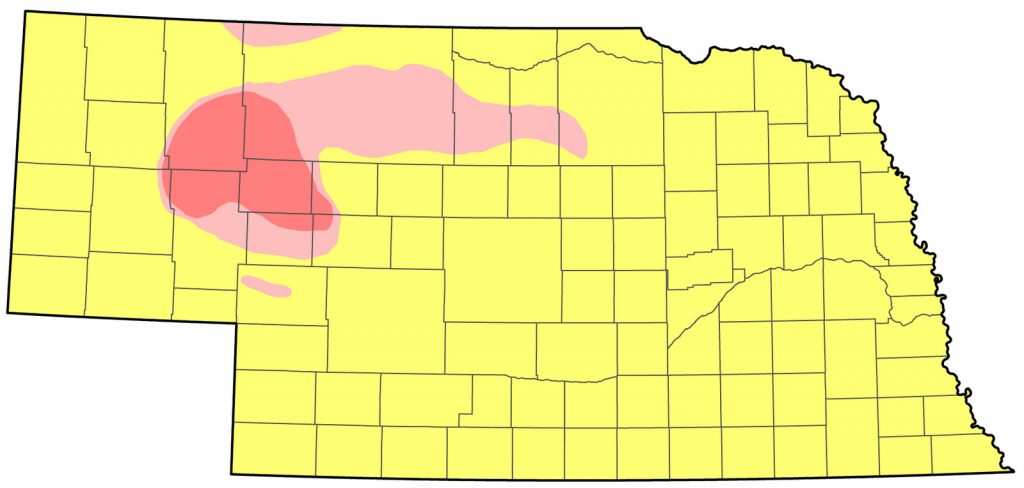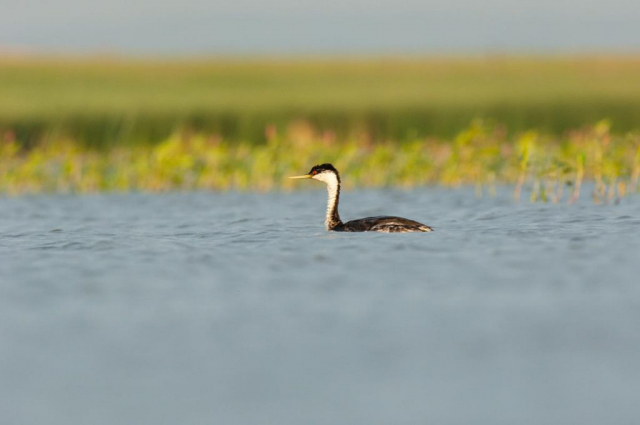Aechmophorus occidentalis occidentalis
Status: Common, locally abundant, regular spring and fall migrant west and central, uncommon east. Locally common regular breeder western Sandhills, rare casual elsewhere north and west. Rare regular summer visitor west and west-central, rare casual elsewhere. Rare casual winter visitor lower North Platte River Valley.

Documentation: Specimen: UNSM ZM14365, summer 1982 Keith Co.
Taxonomy: Two subspecies are recognized, occidentalis in western North America and ephemeralis in western Mexico (AviList 2025).
Nebraska birds are occidentalis.
This species and Clark’s Grebe, A. clarkii, were formerly considered color morphs of a single species, but a high degree of assortative mating (Ratti 1979, Nuechterlein 1981, Nuechterlein and Storer 1982), led to elevation of the morphs to species status (AOU 1983). The two species are sympatric, although Clark’s Grebe is predominant southward (Sibley and Monroe 1990).
Hybridization occurs between the two Aechmophorus species. Konter (2011) found around 3.5% of birds in sympatric breeding populations in California and Oregon were intermediate, and that the percentage of intermediates had increased since earlier studies (Ratti 1979, 1981). Nevertheless, Konter (2011) found sufficient assortative mating between the two species to continue to consider them separate species. Pyle (2008), however, considered the two conspecific.
Two intermediates at Lake McConaughy, Keith Co 27 Sep 1996 had bright orange bills typical of Clark’s Grebe and dark lores typical of Western Grebe; Ratti (1981) noted that bill color is “not as discrete as the facial pattern” and “alone should not be used to identify these species.” Other reported intermediates were at North Platte NWR, Scotts Bluff Co 15 Aug 1997, 1-2 at Lake McConaughy 18 Apr and 9 May 1998, and one with an orange bill and black feathering below its eye was in Dodge Co 27 Nov 2014. See Western x Clark’s Grebe (hybrid) – Birds of Nebraska – Online.
Spring: Mar 27, 28, 28 <<<>>> summer (west, west-central); Apr 14, 15, 15 <<<>>> Jun 9, 10, 10 (east, east-central)
Migration peaks in late April; fewer birds occur in the east. There are earlier westerly reports of three on 4 Mar 2001 at Lake Ogallala, Keith Co, 1-9 Mar 2001 Lake McConaughy, 11 Mar 2013 Garden Co, 16 Mar 1962 Lincoln Co, and 16 Mar 2006 Smith Lake WMA, Sheridan Co, and early easterly reports 18 Mar 2008 Buffalo Co, 28 Mar 2004 Kearney Co, 30 Mar 2011 Platte Co, and 11 Apr 2025 Lancaster Co.
- High counts: 30,000 at Lake McConaughy 30 Apr 2018, 18,000 there 22 Apr 2000, 14,500 there 19 Apr 1997, and 14,100 there 16 May 2008.
- An estimate of 100,000 at Lake McConaughy 23 Apr 2014 was based on a “few birds per acre” on this 14,164 hectare (35,000 acre) lake.
Summer: Highest breeding densities occur in western Sandhills (Wampole and Fichter 1946; Rosche 1982) as well as on Lake McConaughy and Keystone Lake in Keith Co, where breeding was first observed in 1993 (Rosche 1994). Away from these locations records are few; of a family group including three half-grown unfledged young was on the south pond at North Platte SL, Lincoln Co 16 Sep 2010, it bred at Carson Lake, northwest Garfield Co (Blake and Ducey 1991), and an adult carrying a chick was photographed at Harlan Co Reservoir, Harlan Co 16 Jun 2018. Ducey (1988) cited reports of nesting in McPherson Co in 1969 and Lincoln Co in 1972, but no details are available.
Western Grebes routinely occur in small numbers at lakes away from breeding areas in late Jun and Jul, primarily in the west; however, large numbers at Lake McConaughy from late Jun-Jul, far in excess of the breeding population there, are presumably arriving molt migrants (see Fall). Such tallies are 3450-3500 from 27 Jun-9 Jul 2025, 1715 on 19 Jun 2004, and 1805 on 22 Jul 2024. Elsewhere there are numerous reports statewide away from breeding areas of small numbers during late Jun-early Sep.
- Breeding Phenology:
Eggs: 21 May-11 Jul
Dependent Young: 7 Jun-19 Jul
Fall: summer <<<>>> Nov 27, 29, 30 (west, west central), Sep 13, 14, 14 <<<>>> Nov 28, 29, 29 (east, east central)
Late dates for west and west central above are away from Lake McConaughy and Sutherland Reservoir.
Later dates elsewhere are 2 Dec 2011 Lancaster Co, 4 Dec 2020 Lancaster Co, 5-6 Dec 2009 Lancaster Co, 7 Dec 2015 Sarpy Co, 7 Dec 2021 Branched Oak Lake, Lancaster Co, 8 Dec 2016 Buffalo Co, 12 Dec 2010 Frontier Co, 12 Dec 1997 Scotts Bluff Co, 13 Dec 1996 Sarpy Co, 13-14 Dec 2021 (2-4) Harlan County Reservoir, Harlan Co, 17 Dec 2021 Gavin’s Point Dam, Knox Co, 18 Dec 2010 Lincoln Co, 21 Dec 2014 Lincoln Co, 22 Dec 2023 Lancaster Co, 26 Dec 2023 Merritt Reservoir, Cherry Co, 26 Dec 2023 Valley, Douglas Co, 31 Dec 2024 Johnson Lake Gosper Co, and 1 Jan 2000 Harlan Co.
Earlier dates in the east and east central are 2 Aug 2003 Sherman Co, 6 Aug-27 Sep Lancaster Co, 8 Aug 2024 Knox Co, 13 Aug 2024 Wheeler Co, 14 Aug 1993 Clay Co, 16 Aug-3 Sep 2023 Lancaster Co, and 2 Sep 2010 Hall Co.
Movement away from breeding sites may occur as early as mid-Jul shortly after juveniles are capable of flight. Western Grebes undertake a molt migration to favored wing molt sites (Stout and Cooke 2003); Lake McConaughy is a major fall staging area for the species and presumably wing molt occurs there since peak counts are in late Sep, before the birds move on to wintering areas Oct-Nov (LaPorte et al 2020). At Lake McConaughy, high count is 44,000 carefully estimated on 27 Sep 2000. Concerning were counts in 2023 and 2024 far below the peak counts of 35,000, 37,000, and 44,000 from 1999-2014; in 2023 peak tally was only 1300 and in 2024 peak was 6000 on 12 Aug.
Large numbers occur on occasion at Sutherland Reservoir, Lincoln Co; 2300 were there 16 Oct 2016, and 1730 on 13 Oct 2020.
At Lake McConaughy and Sutherland Reservoir, a few birds linger late into Dec and may overwinter (see Winter).
- High counts: 44,000 at Lake McConaughy 27 Sep 2000, 37,000 there 21 Sep 2014, and 35,000 there 26 Sep 1999.
Winter: Recently, small numbers have overwintered at Lakes McConaughy and Ogallala, Keith Co; first midwinter report there was of two at Lake Ogallala 5 Feb 1995. Since then, the pattern has been of good numbers lingering until early Jan, best such count 450 on 2 Jan 2011; a few remain through mid-Feb, such as 14 on 22 Feb 1998, one on 19 Feb 1999, 155 on 19 Feb 2000, and one on 16 Feb 2013.
At Sutherland Reservoir, first known overwintering was in 1997-98, when two were noted 14 Jan; one was there 3 Jan 2011, “a few” were there 7 Jan 2007, one on 16 Jan 2025, 1-2 there 10-18 Feb 2017, and 1-2 were there 20 Dec-2 Feb 2019. One at Sutherland Reservoir 1-17 Mar 2025 likely was a wintering bird.
There are no midwinter (5 Jan-10 Mar) records elsewhere.
Images
Abbreviations
CBC: Christmas Bird Count
NWR: National Wildlife Refuge
SL: Sewage Lagoons
WMA: Waterfowl Management Area (State)
Literature Cited
AviList Core Team, 2025. AviList: The Global Avian Checklist, v2025. https://doi.org/10.2173/avilist.v2025.
American Ornithologists’ Union [AOU]. 1983. The AOU Check-list of North American birds, 6th ed. Allen Press, Lawrence, Kansas, USA.
Blake, L., and J. E. Ducey. 1991. Birds of the eastern Sandhills in Holt County, Nebraska. NBR 59: 103-132.
Ducey, J.E. 1988. Nebraska birds, breeding status and distribution. Simmons-Boardman Books, Omaha, Nebraska, USA.
Konter, A. 2011. Interbreeding of Aechmophorus grebes. Wilson Journal of Ornithology 123: 132-136.
LaPorte, N., R. W. Storer, and G. L. Nuechterlein (2020). Western Grebe (Aechmophorus occidentalis), version 1.0. In Birds of the World (P. G. Rodewald, Editor). Cornell Lab of Ornithology, Ithaca, NY, USA. https://doi.org/10.2173/bow.wesgre.01
Nuechterlein, G.L. 1981. Courtship behavior and reproductive isolation between Western Grebe color morphs. Auk 98:335-349.
Nuechterlein, G.L., and R.W. Storer. 1982. The pair-formation displays of the Western Grebe. Condor 94: 351-69.
Pyle, P. 2008. Identification Guide to North American Birds. Part II, Anatidae to Alcidae. Slate Creek Press, Bolinas, California, USA.
Ratti, J.T. 1979. Reproductive separation and isolating mechanisms between sympatric dark- and light-phase Western Grebes. Auk 96: 573-586.
Ratti, J.T. 1981. Identification and distribution of Clark’s Grebe. Western Birds 12: 41-46.
Rosche, R.C. 1982. Birds of northwestern Nebraska and southwestern South Dakota, an annotated checklist. Cottonwood Press, Crawford, Nebraska, USA.
Rosche, R.C. 1994. Birds of the Lake McConaughy area and the North Platte River valley, Nebraska. Published by the author, Chadron, Nebraska, USA.
Sibley, C.G., and B.L. Monroe, Jr. 1990. Distribution and taxonomy of birds of the world. Yale University Press, New Haven, Connecticut, USA.
Stout, B.E., and F. Cooke. 2003. Timing and Location of Wing Molt in Horned, Red-necked and Western Grebes in North America. Waterbirds 26: 88-93. DOI: http://dx.doi.org/10.1675/1524-4695(2003)026[0088:TALOWM]2.0.CO;2.
Wampole, J., and E. Fichter. 1946. Western Grebes nesting at George Lake, Grant County. NBR 14: 45.
Recommended Citation
Silcock, W.R., and J.G. Jorgensen. 2025. Western Grebe (Aechmophorus occidentalis). In Birds of Nebraska — Online. www.BirdsofNebraska.org
Birds of Nebraska – Online
Updated 20 Aug 2025

